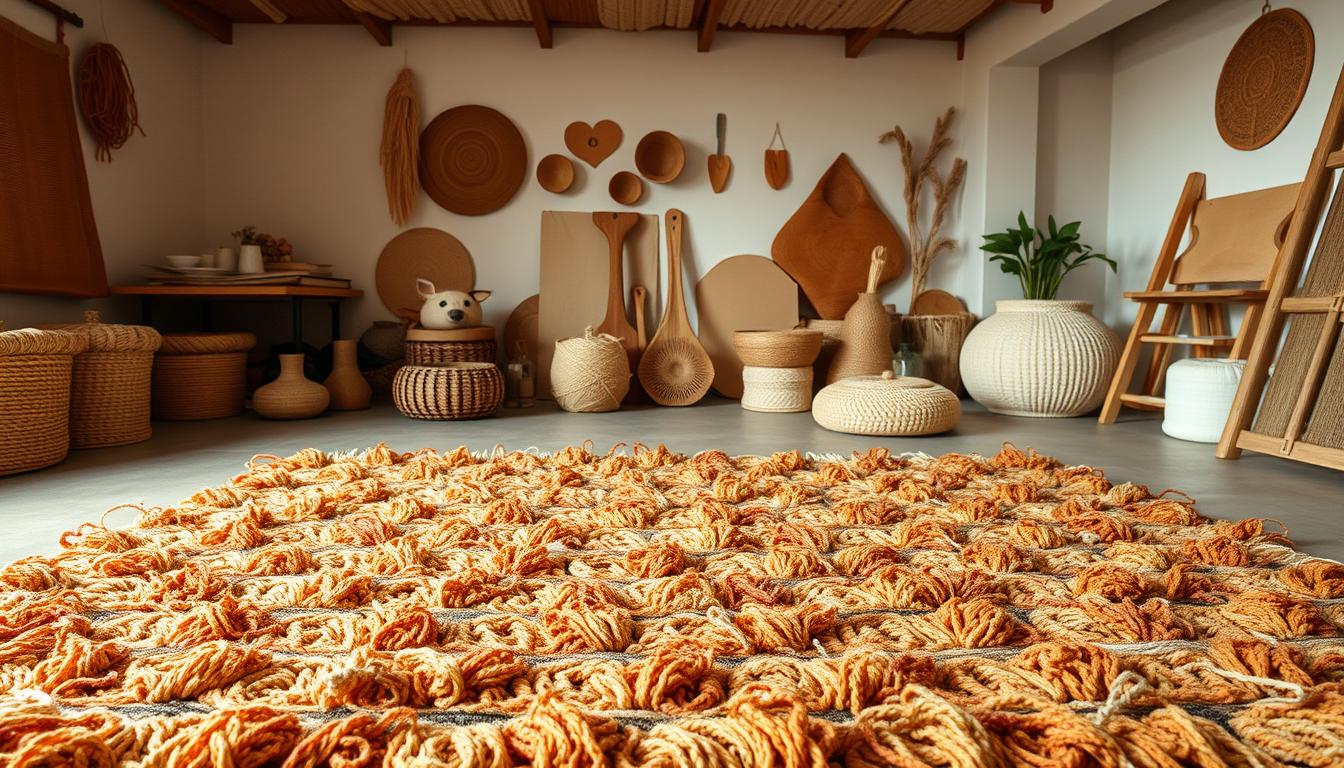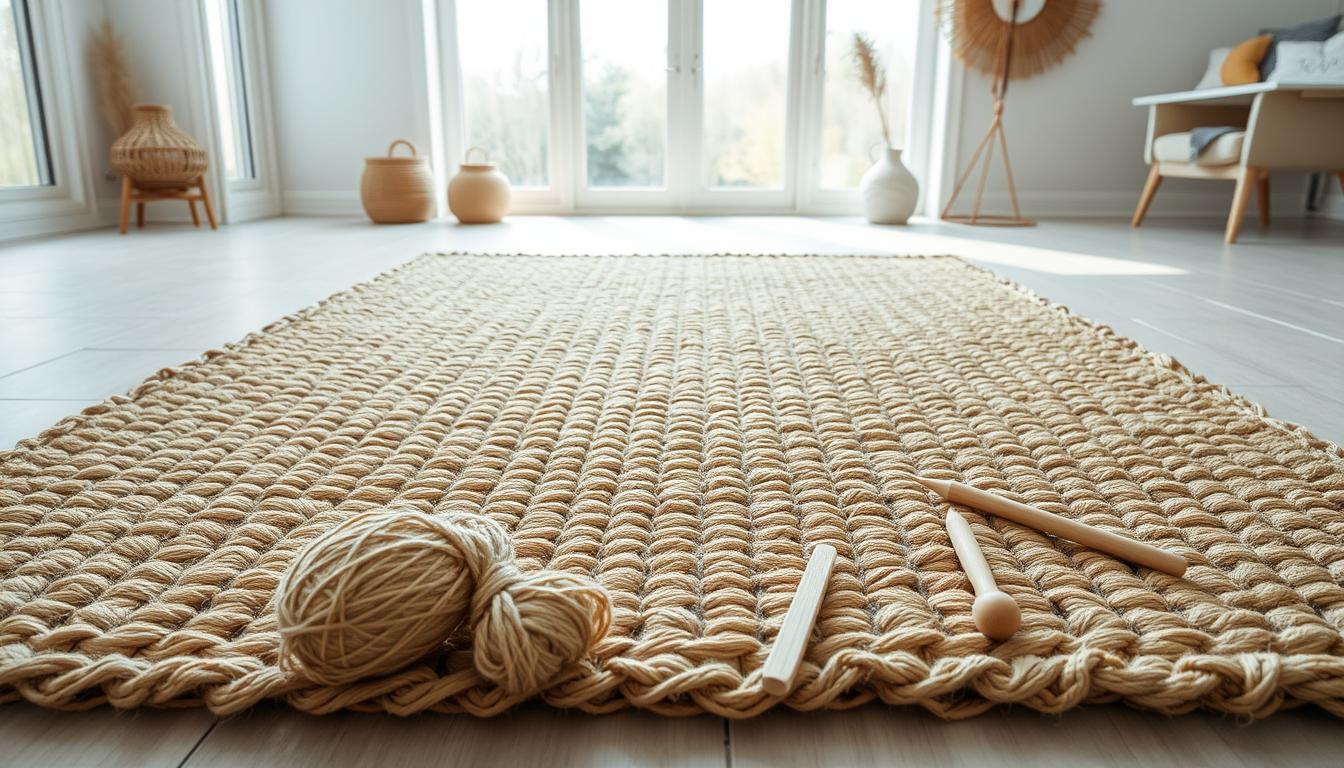
7 Pure Steps to Make a Natural Fiber Rug
What if your dream rug isn’t in stores? Most ready-made options never fit unique spaces perfectly. But here’s the secret: you don’t need to settle or overspend. With basic tools and a little patience, you can reshape handwoven pieces to match your room’s exact dimensions.

Jute rugs stand out for their earthy texture and durability. Their loose, fringed edges let you shorten them from both ends without altering the width. This makes customization surprisingly straightforward—even for beginners. You’ll need scissors, a ruler, and about three hours to unweave and re-knot the fibers.
Ever wondered why dirt collects in rugs over time? As you work, you’ll uncover hidden debris trapped in the weave. It’s a reminder of how these pieces age—and why refreshing their size adds new life. Best of all, this project costs a fraction of ordering custom sizes from retailers.
Ready to create something that fits like it was made for your home? Let’s dive into the process.
Key Takeaways
- Customize handwoven rugs to fit any space without expensive retail markups.
- Jute’s frayed edges and simple construction allow easy resizing in under 3 hours.
- Basic household tools are all you need for professional-looking results.
- Expect to remove trapped dirt during the unweaving process—a normal part of older rugs.
- Save up to 80% compared to buying pre-sized luxury options.
Understanding Natural Fiber Rugs
Ever considered the hidden advantages of earthy home textiles? Materials like jute and wool bring unmatched character to rooms while offering practical perks. Their breathable nature regulates indoor humidity, and their tight weaves resist wear better than many synthetic counterparts.
Why Natural Fibers Shine
Jute’s loose weave hides crumbs and minor stains, perfect for busy kitchens or play areas. Unlike flat-woven synthetics, its textured surface scatters light to mask debris. Shedding a few fibers initially? That’s typical—it shows your rug wasn’t chemically treated to bind strands artificially.
Wool dhurries offer softer textures but need gentler care. Their natural lanolin resists spills temporarily, giving you time to blot accidents. However, wool requires specialized cleaning powders—water damages its structure over time.
Picking Your Perfect Match
For DIY projects, prioritize jute’s forgiving nature. Its knotted ends unravel cleanly for resizing, then re-tie securely. Wool works better in low-traffic zones like bedrooms where softness matters most. Both materials age beautifully, developing a patina that tells your home’s story.
Always check for handwoven construction with visible fringe—this indicates a rug built for customization. Store-bought glued edges won’t withstand adjustments. With proper care, these pieces last decades, maturing like fine leather rather than wearing out.
DIY Guide: how to make Natural Fiber Rug

Customizing earth-friendly floor coverings begins with precise preparation. Lay your piece flat and measure twice—mark removal points with chalk on both ends. This ensures symmetrical adjustments while preserving the weave’s structural integrity.
Preparing Your Rug for Resizing and Customization
Untie fringe knots methodically, working from one corner inward. You’ll notice dust particles escaping—a normal occurrence in older pieces. Keep a vacuum nearby to clean debris as you uncover hidden layers.
Record the original knot pattern using your phone’s camera. This visual reference becomes crucial when replicating the design later. Calculate material removal by subtracting your desired size from current dimensions—divide this number equally between both sides.
Mastering Unweaving and Fringe Techniques
Separate strands individually using a blunt tapestry needle. Work against the grain to prevent accidental tears. Expect to remove up to 1/4 cup of dirt per square foot in well-used pieces—this deep cleaning revitalizes the textile’s appearance.
Preserve loose fibers in a ziplock bag. These extras prove invaluable if you need to patch thin areas during reassembly. Maintain consistent tension while unraveling to keep edges straight.
Re-knotting Methods and Finishing Touches
Recreate fringe using the 2:1 curly-to-straight strands ratio. Thread straight fibers through loops first, then weave curly counterparts clockwise. Tighten knots gradually—rushing causes uneven tension.
Trim excess material with fabric shears once secured. New fringe curls naturally within 48 hours, blending seamlessly with the original design. For prolonged focus during this 3-hour project, try instrumental playlists and dark roast coffee—they help maintain rhythm through repetitive tasks.
Customizing and Enhancing Your Rug
Transform your space without breaking the bank. Strategic modifications let standard pieces adapt to unique layouts while maintaining their organic charm.

Adjusting Size and Fit for Your Space
Combine two 8x11 pieces for grand living areas. Use heavy-duty upholstery thread, stitching every 12 inches beneath overlapping edges. IKEA Tarnby and Pottery Barn options blend seamlessly when aligned grain-to-grain.
Measure doorways and furniture paths first. Leave 18 inches of bare flooring around perimeter walls—this prevents tripping hazards and visual clutter. For irregular room shapes, cut templates from craft paper before trimming fibers.
Maintenance Tips and Managing Dirt & Stains
Blot spills immediately with cornstarch—it absorbs liquids without damaging jute’s structure. For ground-in particles, use stiff brushes and our specialized cleaning guide to preserve weave integrity.
Rotate pieces quarterly to distribute wear. Non-slip pads prevent shifting on hardwood while protecting floor finishes. “Thicker pads extend your textile’s life by 40%,” notes a New York interior designer survey.
Address frayed edges promptly with fabric glue. Store extra binding thread from your project—it’ll match perfectly for future repairs.
Conclusion
Rethink your floors: tailored textures that mirror your lifestyle. Your resized jute rug now fits like it grew there naturally. This project proves custom looks don’t require luxury budgets—just smart techniques and household tools.
You’ve mastered more than measurements. Those unraveled strands taught you about fiber behavior under tension. The re-knotted fringe revealed how simple tweaks refresh entire spaces. Store-bought options can’t match this level of personalization.
Maintenance becomes effortless with your new skills. Rotate pieces seasonally to balance wear. Address spills quickly using cornstarch or our stain removal guide for stubborn pet accidents. These practices triple your textile’s lifespan.
Future projects await—patch worn areas, combine smaller rugs for grand rooms, or dye fibers for bold statements. Each modification deepens your connection to home spaces. Your floors now tell stories of craftsmanship, not catalog orders.
Today’s work pays dividends for years. Every snip and knot fuels confidence to reshape surroundings. That’s the power of hands-on creation—it transforms houses into habitats.
FAQ
What makes jute a popular choice for natural fiber rugs?
Jute is durable, eco-friendly, and adds earthy texture to spaces. Its neutral tones blend well with most decor styles, while its coarse strands hold up well in low-to-medium traffic areas like living rooms or bedrooms.
Can wool rugs handle stains better than jute?
Yes. Wool naturally repels moisture and resists stains, making it ideal for high-traffic zones. For jute, immediate spot-cleaning with mild soap is key to prevent permanent marks.
How do you adjust a rug’s size without damaging it?
Carefully unweave the edges row by row, keeping strands intact. Use a crochet hook or needle to re-knot trimmed ends, ensuring the new dimensions fit your space without fraying.
What’s the best way to maintain natural fiber rugs?
Vacuum weekly without a beater bar to avoid pulling fibers. Rotate the rug every 3–6 months to evenly distribute wear. For spills, blot—never scrub—to prevent spreading dirt deeper.
Are jute rugs suitable for outdoor use?
No. Jute absorbs moisture, leading to mold in humid environments. Opt for synthetic alternatives like polypropylene for patios or decks.
Can you add custom fringes to a DIY rug?
Absolutely. After unweaving the edges, twist loose strands into tassels or braids. Secure them with tight knots or fabric glue for a personalized touch.
How long do natural fiber rugs typically last?
With proper care, they can last 5–10 years. Wool tends to outlast jute due to its resilience, especially in busy areas. Avoid direct sunlight to prevent fading over time.








